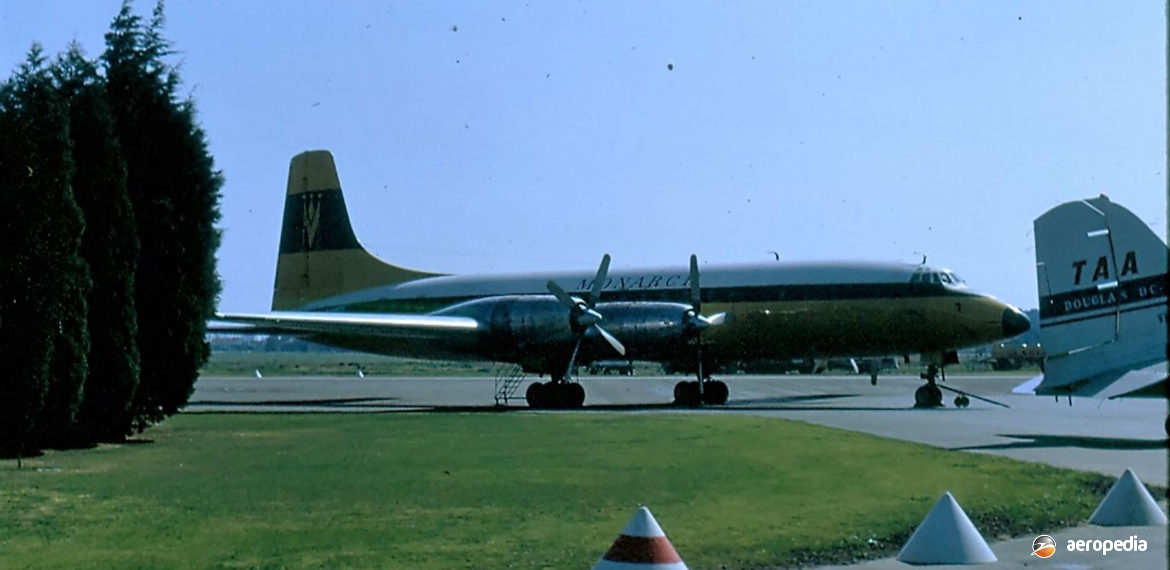Photograph:
Bristol Britannia Series 305 G-ANCF (c/n 12922) of Monarch Airlines at Adelaide Airport, SA in August 1969 (David C Eyre)
Country of origin:
United Kingdom
Description:
Long-range commercial airliner
Power Plant:
Four 3,074 kw (4,120 ehp) Bristol Proteus 755 turboprops
Specifications:
- [BRITANNIA 102]
- Wingspan: 43.36 m (142 ft 3 in)
- Length: 37.87 m (124 ft 3 in)
- Height: 11.43 m (37 ft 6 in)
- Wing area: 192.77 m² (2,075 sq ft)
- Max speed: 639 km/h (397 mph)
- Cruising speed: 575 km/h (357 mph)
- Service ceiling: 7,315 m (24,000 ft)
- Range with max payload: 6,869 km (4,268 miles)
- Empty weight: 39,191 kg (86,400 lb)
- Loaded weight: 70,308 kg (155,000 lb)
History:
In 1943 the Brabazon Committee convened to discuss the future development of civil aviation in the United Kingdom and out of this came the Britannia which eventually was a turboprop powered airliner.
In 1948 three prototypes of the Bristol Britannia were ordered by the British Ministry of Supply with the Bristol Centaurus engine. However, on 28 July 1949 British Overseas Airways Corporation (BOAC) ordered a fleet of 25 which were to be powered by the Bristol Proteus turboprop, the prototype G-ALBO (c/n 12873) making its first flight on 16 August 1952 at Filton in South Gloucestershire.
The Committee laid down guidelines and considered new ”Empire Routes” would be required but by 1946 it was necessary to introduce the Lockheed 049 Constellation into service. The Avro Tudor was considered to be too small and this led to the Type 175 with Centaurus piston engines. By this time the Proteus had begun bench tests and was expected to be fitted to the Bristol Brabazon and the Saunders Roe Princess. Some re-design of the Britannia was necessary to bring it up to 90 passengers in tourist class configuration. By August 1953 the Proteus 705 engines were providing 2,909 kw (3,900 hp). The second prototype (G-ALRX) flew on 23 December 1953 and this was representative of production aircraft but this aircraft was lost when a compressor turbine failed and the aircraft made a forced landing on the Severn mudflats.
However, even at this stage the writing was on the wall for turboprop aircraft for long distance flights as in August 1954 the prototype Boeing 707 flew and orders for the Britannia were thereafter not forthcoming. By 1956 route proving flights and sales tours were being conducted but there were operational problems with the engines. There was still American and Canadian interest in the type. Northeast Airlines signed a contract for five and Capital Airlines sought to obtain 15. An important route flown by the Britannia as far as this part of the world is concerned was the Amsterdam in The Netherlands to Sydney and Auckland route via Vancouver, Canada, Honolulu in Hawaii and Fiji twice a week (21,626 km – 13,438 miles).
The Britannia also saw service with the RAF in Series 200 and Series 300 form operating at Lyneham in Wiltshire and Brize Norton in Oxfordshire. These aircraft regularly visited Australia and New Zealand. Twenty-three aircraft were operated by Nos 99 and 511 Squadrons RAF. None were lost during service with the RAF.
A derivative of the Britannia was the CC-106 (or CL-44-6) originally planned as a stretched Britannia powered by Bristol Orion engines but when built for the RCAF Air Transport Command it had Rolls Royce Tyne 12 turboprops, the first aircraft having a long-range cruising speed of 612 km/h (380 mph) and being able to carry a payload of 27,433 kg (60,480 lb) over 3,798 km (2,360 miles) with reserves for two hours of holding at 4,572 m (15,000 ft). Twelve of these aircraft had side-door cargo loading. Commercial variants were built as the CL-44D-4 and CL-44G for Flying Tiger Line and Seaboard & Western. These aircraft had a swing tail for loading, the engines by that time producing 4,849 kw (6,500 ehp).
The Britannia entered service with BOAC, the first crossing from London Airport to Idlewild, New York, taking place on 28 September 1957 in a time of 11 hrs 39 mins. Other major operators of the type included El Al (Israel), Canadian Pacific, Hunting-Clan Air Transport, and Cubana. On 19 December 1957 an El Al aircraft (4X-AGA) flew from New York to Tel Aviv, Israel a distance of 9,817 km (6,100 miles) at a speed of 645 km/h (401 mph). After withdrawal from service the type was used for some years by freight operators.
In the 1950s the Britannia was regularly seen in Australia in BOAC service, as well as with British Eagle and Monarch Airlines in later years. Britannias serviced the Sydney – London route for some years, eventually being replaced by the de Havilland Comet, and later the Boeing 707. During February and March 1973 severe flooding took place between Adelaide, SA and Darwin, NT causing washaways of road and rail traffic. At this time, to assist in providing food and supplies to the areas affected, two Monarch Airlines Britannias were chartered by Trans Australia Airlines (TAA) to operate relief flights in the regions affected.

